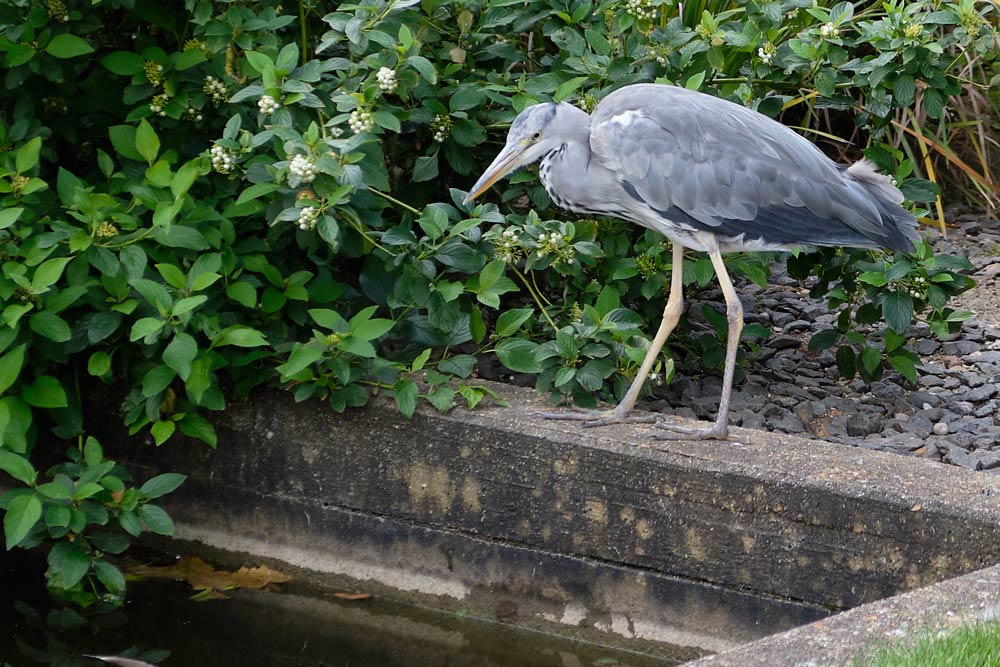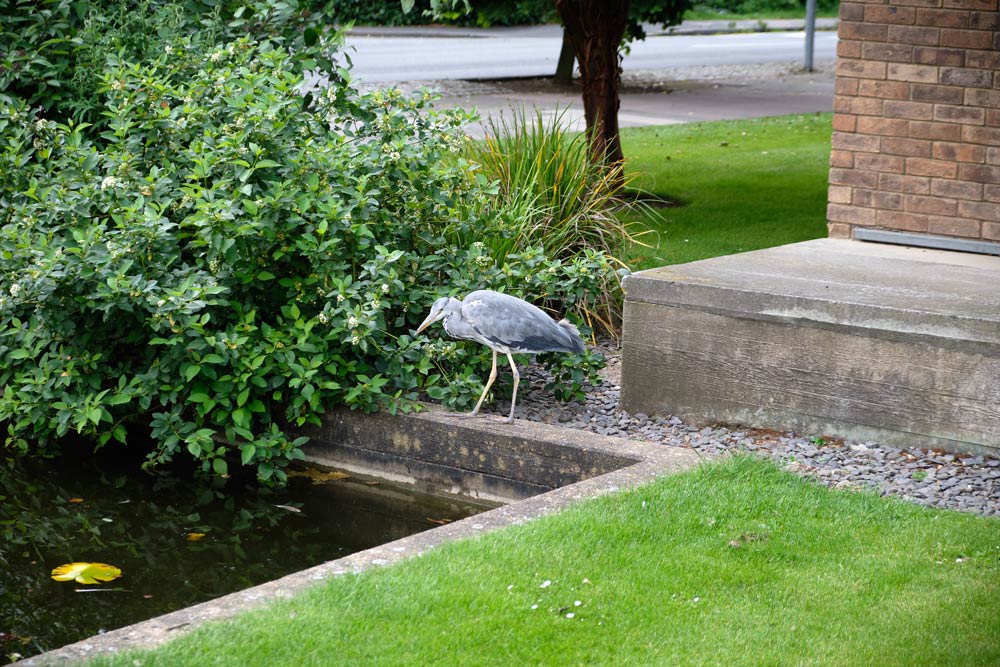

I thought I would show how the Fuji X-T2 with the 18-55mm lens stands up to closer examination. It might not have been obvious from the earlier post today, but the photo of the heron is a crop from the full frame.
So here is another with the heron in the corner of the pond, this time showing the full frame as well.
You can see how near the road the heron was standing.
Near the road (and yet well hidden 😉 )
LikeLike
It’s noticeable how tame birds in Cambridge are. Ducks sit within inches of passers in the parks that run through the middle of town. Blackbirds tug at worms by the footpath, wrens flit by in the low branches. There must be a long history or bird friendliness here. 🙂
LikeLiked by 1 person
Mmm… House Wrens are notoriously unimpressed by human activity (and will evict the young of other occupants )
LikeLike
We have a long history of wiping out species here…
LikeLike
I am a great believer in providing naturally occurring food and habitat but decry the direct encouragement/ dependence of wild creatures…
LikeLike
I am the same – except where the animals are hunted or deprived of habitat and risk extinction. Then I am in favour of zoos, safari parks, Ramsar sites, and bird reserves with feeding stations and anything else that will keep them from the brink. I was just thinking this morning that I don’t care what the silly politicians do in their games, but when they turn the skies leaden and the Earth brown, then they are unforgivable.
LikeLiked by 1 person
Aye, like ‘Developers’ employing (fruit) netting on hedgerows to prevent nesting so they can raze hedgerows, you mean? (GRRRR:/) and over here, the ‘Agri-Businessmen’(sure as hell won’t call them Farmers, as that’s an honourable profession) who drain wetlands and destroy hedgerow habitat so they can run their Behemoth Monstrosities without needing to stop for fence or marshland or nesting species… *moronic*
LikeLike
Yes, exactly so. I recently bought a copy of ‘Wilding: The return of nature to a British farm’ but haven’t started it yet. Well, just a few pages.
LikeLiked by 1 person
Mmm… Having fun attempting to identify a Dogwood/Cornus species with green twigs and white berries… Any suggestions David?
LikeLike
I think you are right – the leaves look correct with the lines in them.
LikeLike
Oh I have at least two different Dogwood species here in the gardens close to the house – both Red Osier (Cornus stolonifera/formerly C. sericea) and Green-Twig – but not entirely sure if the berries on mine are white or a purple/blue (the birds always get them, so I’ve not been able to get rock-solid species identification…
LikeLike
I am nuts about flowering Dogwood trees. We don’t have them in the UK, so the first time was when I visited Tamara’s family home.
LikeLiked by 1 person
Ah yes, that would be C. florida. They are incredibly beautiful, but sadly, prefer it just a touch warmer than in my part of the province:/
LikeLike
How cold can it get where you are?
LikeLike
Well, depending on the winter (things have been getting totally out-of-whack over the last decade:/) it can get down to -30 every now and again; specially with the windchill added on…
LikeLike
That’s cold… 🙂
LikeLike
LOL, was just rereading our conversation and realised that you’d asked “how old do they get here?”, and not “how cold does it get?”
LikeLike
Corrected – thank you! 🙂
LikeLike
Both of my (named ones; ) are Alders: the Red (Cornus sericea) and Green (C. alternifolia)
Not sure if I lost the response to your query or it’s just in waiting, but temps here can range from -30°C in the Dead of Winter all the way up to the 30’s in the ‘Dog Days’ of Summer; so plants must be versatile (to say the least; )
LikeLike
Your previous comment has just been waiting. I was out and then saw a flower on my way back and went out again to photograph it. I made a bad job of it, so I will try again tomorrow when the light is good.
Yes, that is a very broad range of temperatures. I have never experienced -30°C. I experienced around -20°C in Finland, but the cold was dry, so it felt OK. At least it felt OK until my eyelashes would freeze and the spittle in my mouth would get thick, and my knees would stop bending easily. Then it was time to come indoors.
LikeLiked by 1 person
And yes, you KNOW it’s cold when your lashes (and nostril hairs:/) freeze, lol
LikeLike
Believe it or not, the most important thing to maintain warmth in the winter (and cooling in the Summer too, for that matter; ) is ensuring that your body is always kept well-hydrated!
LikeLike
I hadn’t thought about hydration in cold weather. That’s one to keep in mind.
LikeLiked by 1 person
How do you cope with the cold?
LikeLike
LOL! Wow, I had to stop and think about that for a bit. Well layering, lots of layering when you need it – more outside, less in – and wool is good but shearling is wonderful; ) Of course these are the seasonal extremes David. It’s not always that way, nor do they last for all that long at a stretch, as a rule. And, as for the plants, well that’s why I prefer Native Species; do no pruning until March when the worst of the winds are over and most importantly, leave fallen leaves where they fall as a first layer of protection; then, assuming we have a good snow cover, things stay quite toasty while they sleep; )
LikeLike
I have heard the word ‘shearling’ but didn’t know what it was. I looked it up and it says “Shearling is a skin from a recently shorn sheep or lamb that has been tanned and dressed with the wool left on.” Is that your use of the word?
Leaving leaves on the ground where they fall sounds a sympathetic approach.
LikeLiked by 1 person
Yes indeed! Shearling, most often sheep’s skin is tanned as a “fur” and makes wonderfully cosy, incredibly durable outerwear – everything from slippers, hats, boots and jackets. I have a pair of mittens that’re most likely lamb. Did you ever watch the television show “Heartbeat”? Dr. Meg Rowan often wore a shearling jacket: )
LikeLike
I’ve enjoyed looking at your beautiful heron photos. We have the Great Blue Heron here. Off the beach I mentioned [about the holy water], there are two, tiny islets [protected] where they breed. We also get egrets … both snowy and the other one.
One time a great blue had ventured out to Rockwood Park, where I go often. He was sauntering around the lake, and I got some half-decent close-ups of him.
LikeLiked by 2 people